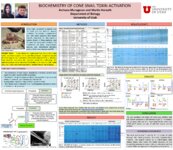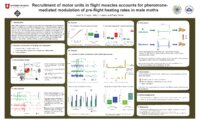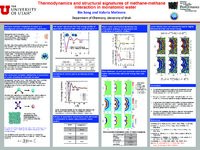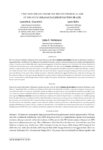TO
1 - 25 of 11
| Creator | Title | Description | Subject | Date | ||
|---|---|---|---|---|---|---|
| 1 |
 | Horvath, Martin P. | Biochemistry of Cone Snail toxin activation | Cone snails use venom to capture prey for food and for defense against predators. The venom is composed of over 100 active peptides that target specific receptors in the nervous system. Several of these peptides have the potential to become medicine for treatment of pain, depression, seizures, and n... | biochemistry; horvath; olivera; cone snail; toxin; nmda; elution; buffers; sparse matrix test; protease; protein; purification; neurotoxin; conotoxin | 2013 |
| 2 |
 | Yamaguchi, Ayako | Distinct neural control of vocal phases in frog calls | This poster describes how the connections within the central vocal pathways of African clawed frogs are responsible for coordinating distinct part of their calls. | Vocalizations; Central pattern generators, Motor programs | 2013 |
| 3 |
 | Crespo, Jose Guillermo | Recruitment of motor units in flight muscles accounts for pheromone-mediated modulation of pre-flight heating rates of males moths | Insecta; Physiology; Pheromone; Thermobiology; Muscle; Flight; Behavior; Helicoverpa zea | 2013 | |
| 4 |
 | Song, Bin; Molinero, Valeria | Thermodynamics and structural signatures of methane-methane in monatomic water | 2013 | ||
| 5 |
 | Dearing, Maria-Denise | [Dearing_Database_Pilot] | [Database deposited March 08, 2013, as part of a pilot project, eResearch Committee, University of Utah.] [This description should include information that explains the dataset in detail in a manner that would be useful to potential reuse. The contact information for the primary investigator should ... | [Creator keywords here.] | 2013-03-08 |
| 6 |
 | Armentrout, Peter B. | The bond energy of ReO+: Guided ion-beam and theoretical studies of the reaction of Re+ (7S) with O2 | The kinetic-energy dependence of the Re+ + O2 reaction is examined using guided ion-beam mass spectrometry. The cross section for ReO+ formation from ground state Re+ (7S) is unusual, exhibiting two endothermic features. The kinetic energy dependence for ReO+ formation is analyzed to determine D0(Re... | 2013-01-01 | |
| 7 |
 | Crespo, Jose Guillermo | Dislodgement effect of natural semiochemicals released by disturbed triatomines: a possible alternative monitoring tool | The quick detection of domestic and peridomestic triatomines in their environments becomes difficult without the use of dislodgement substances that flush them out from their shelters. At present, tetramethrin 0.2% is being widely used in control programs. Although it is an efficient dislodging agen... | 2013-01-01 | |
| 8 |
 | Clayton, Dale H. | Does avian malaria reduce fledging success: an experimental test of the selection hypothesis | Like many parasites, avian haematozoa are often found at lower infection intensities in older birds than young birds. One explanation, known as the "selection" hypothesis, is that infected young birds die before reaching adulthood, thus removing the highest infection intensities from the host popul... | 2013-01-01 | |
| 9 |
 | Minteer, Shelley D. | Nickel-DNA complexes: bioelectrocatalysis or not? | Alkaline fuel cells (AFC) are low temperature, quick-to-start devices that can achieve 50% operating efficiency. Low cost alternatives to platinum group electrocatalysts, which allow for direct reformation are desired. Nickel electrocatalysts are highly active in alkaline for the oxidation of fuels.... | 2013-01-01 | |
| 10 |
 | Bohs, Lynn A. | Two new species from the brevantherum clade of solanum (solanaceae) from eastern Brazil | Two new species of Solanum (Solanaceae) from eastern Brazil are described. Solanum anisocladum Giacomin & Stehmann is similar to S. megalochiton Mart., but differs by the indument of the adaxial leaf surface, which is composed of long porrect-stellate and unbranched trichomes. It also has a more rob... | 2013-01-01 | |
| 11 |
 | Minteer, Shelley D. | Utilizing DNA for electrocatalysis: DNA-Nickel aggregates as anodic electrocatalysts for methanol, ethanol, glycerol, and glucose | DNA-nickel aggregates were electrodeposited onto glassy carbon electrode surfaces and have shown electrocatalytic activity for oxidation of methanol, ethanol, glycerol, and glucose at room temperature in alkaline solutions. Bulk electrolysis oxidation products identified by 13C NMR include carbonate... | 2013-01-01 |
1 - 25 of 11
